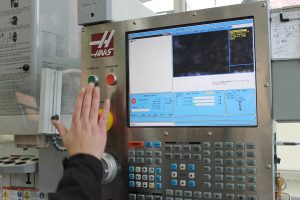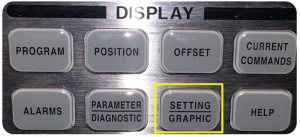
Tech Tuesday is a weekly blog that addresses some of the most common questions and concerns that I hear throughout the previous week from users of BobCAD’s CNC software. Both customers and future customers are more than welcome to leave a comment on what they would like to see covered for the following Tech Tuesday. If you missed last week’s Tech Tuesday, click here.
Today’s article has to do with communicating with your Haas CNC machine using RS-232. What is RS-232? It stands for Recommended Standard 232. It refers to a standard originally introduced in the 1960s for serial communication transmission of data. It formally defines signals connecting between a DTE (Data Terminal Equipment) such as a computer terminal, and a DCE (Data Communication Equipment), such as a modem. The standard defines the electrical characteristics and timing of signals, the meaning of signals, and the physical size and pinout of connectors.[1] Follow along below to learn how to simply send and receive programs from controller to computer.
Settings
To get into the RS-232 settings in the Haas controller, press the Setting/Graphic button.

In the settings view, press the ‘>’ key to get over to the I/O tab. Press ‘Enter’ to display the page.
Current Settings in Haas Control
• Setting 11– Baud Rate – 9600
• Setting 12– Parity Select – Even
• Setting 13– Stop Bit – 2
• Setting 14– Synchronization – XON/XOFF
• Setting 37– RS-232 Data Bits – 7
• Setting 25– EOB Pattern – CR LF
• Setting 41– Add Spaces RS-232 Out – ON
• Setting 156– Save Offset with Program – ON (this can be turned off if you do not want the offsets).
Note: Make sure you match these settings in the software used on the PC for communications.
Sending Program From Controller to Computer
The following steps will guide you through sending a program from the controller to the computer/PC.
1. On the computer, get the program you are using for communications ready to receive.
2. On the Haas controller, press the ‘Memory’ button to make sure you are in Memory Mode.
3. Press the ‘List Program’ button to display the list of programs stored in the controller’s memory.
4. Enter the program number you wish to send from the controller. Ex: O300 (start with the letter “O”, not Zero).
5. Press the ‘Send’ button to send the program. The program will now be sent from the controller to the computer.
Note: When the program is sending from the controller, the status bar on the control will show “Sending…..”. If the status bar does not show this, you may need to reboot the controller as the port could be locked up from previous attempts.
Subscribe to BobCAD-CAM's Tech Tuesday Blog
Join your fellow machinists. Get the latest Tech Tuesday CAD-CAM articles sent to your inbox. Enter your email below:
Receiving A Program From Computer To The Controller
The following steps will guide you through receiving a program into the machine’s controller from the computer.
1. On the Haas controller, press the ‘Memory’ button to make sure you are in Memory Mode.
2. Press the ‘List Program’ button to display the list of programs stored in the controller’s memory.
3. Press the ‘V’ (downward-facing triangle) button until the selection is on the “ALL” entry (this is important).
4. Press the ‘Receive’ button to begin receive mode on the controller. The controller status bar should now display “Waiting For Data”.
5. On the computer, send the program.
Important Notes for RS-232 Communications
% Symbols– The Haas controller uses the % symbol to define the start and end of the data that is being received into the controller. The % sign must reside at the beginning and end of the program you wish to be loaded into the controller.
You can have additional information before the 1st % symbol and after the last % symbol in the file residing on the computer. The communications between the Computer and Controller will automatically ignore this extra data and only the lines of information found in between the two % symbols will be received by the controller.
If you send a program to the machine that does contain extra data before and after the % symbols, it’s important to understand that data will be gone if you send the program back to the computer from the machine’s controller.
Multiple Programs Sent at Once– You can send a file from the computer to the machine’s controller and when received the programs will show in the listing as separate programs. An example of this would be the main program and its subs. This can be achieved by having a single file on the computer that contains multiple Oxxxx program numbers inside the beginning and end of the % symbols.
Example:
%
O100 (MAIN PROGRAM)
…
…
…
O150 (SUB 1)
…
…
…
M99
O160 (SUB 2)
…
…
…
M99
%
When the previous program is read into the machine’s controller, you will see 3 separate programs show up in the program listing:
•O100
•O150
•O160
Fifo Buffers– When you are setting up communications, you should disable the Windows Fifo buffers. These are found by going into the properties of the COM port in the Windows Device Manager. With the Fifo buffers enabled, you will run into parity errors when sending programs at high baud rates or when sending long NC programs. Thank you so much for reading another Tech Tuesday; see you next week!
You’re one click away from subscribing to BobCAD’s YouTube channel. Click the link below for tips, how-tos and much more!
BobCAD-CAM has provided CAD-CAM CNC Software products to the global manufacturing industry for over 30 years. BobCAD-CAM software can be found to increase CNC productivity for many applications in aerospace, automotive, production manufacturing, mold making, general machining, woodworking as well as the medical manufacturing industry, consumer products, musical instruments, custom fabrication, defense industry and many others due to the products ability to automatically generate NC programming code for such a wide variety of CNC controllers. BobCAD-CAM software is also found in educational institutions throughout the world as well as independent hobby home use. Products include machining technology for 2, 3, 4 & 5 Axis CNC Milling, Routing, Waterjet, Plasma and Laser machines as well as 2 Axis CNC Lathe. BobCAD-CAM is modular allowing shops to start off at a reduced technology level and add technology as it is needed including an add-on, BobART, for artistic machining. Unique technology includes adaptive high-speed machining multiaxis milling and routing which is a first in the world of CAD-CAM software. BobCAD-CAM also provides a variety of quality training products that include regional and online training classes or private sessions tailored to specific applications. Professional certification and multi-tiered support solutions are available. Contact BobCAD-CAM directly for more information at 877-262-2231 or 727-442-3554.
Sources:
[1] Wikipedia. RS-232, 02 July 2019, Resource 1